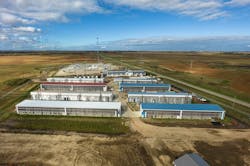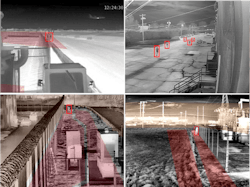How AI and Thermal Imaging Are Redefining Data Center Defense
The Skinny
-
Early detection is critical: Thermal cameras with AI identify intrusions at the perimeter before threats reach critical assets.
-
Geospatial tracking enhances accuracy: Systems calculate object size, speed, and location to reduce false alarms.
-
Dual-spectrum AI boosts reliability: Combining thermal and visible analytics ensures 24/7 threat detection in any condition.
Data centers are the backbone of the digital economy as they store and process vast amounts of critical information that commercial, military and government entities require to be safely held. The increased reliance on networks that operate at the speed of light necessitates a robust protection strategy as these facilities face heightened risks from physical threats.
Understanding that physical security starts at the perimeter, data centers are applying the same strategy that is common in network security — where firewalls, antivirus, and other cybersecurity methods are standard practice — and extending it to the perimeter boundary around the facility itself. Early and accurate detection of an intruder is the first action necessary to defend a data center from potential damages of a physical threat. It’s become more critical than ever to embrace a “detect early, never miss a threat” approach to perimeter security — one that delivers real-time, reliable alerts.
Such a “zero-trust” approach to perimeter security starts with reliable threat detection at or even outside the fence line — before intruders can compromise critical assets. While multiple strategies exist to achieve this, thermal detection with artificial intelligence (AI) technology provides continuous, 24/7 protection over large perimeters, even in darkness and bad weather. The result is an automated “Building-to-Perimeter” buffer zone that functions as reliably as the firewalls and intrusion detection systems that protect the data center’s network.
The Case for Zero-Trust Perimeter Security
Zero-trust is a cybersecurity principle that assumes no entity — internal or external — should be inherently trusted. This concept continuously monitors and verifies who and what is requesting access to a network or application. Similarly, detection and verification at the outermost fence line protects access to a data center’s physical perimeter.
Because unauthorized physical access can be as damaging as a cyber breach — risking data theft, service disruption and reputation — early detection prevents intrusions before they reach their internal targets. This approach provides security teams with additional time to safeguard data from theft, sabotage, or destruction.
Like most outdoor applications, data centers present challenges: large open spaces, low or no light, and constant environmental changes. Perimeter systems used to protect these critical sites must detect without fail and differentiate genuine threats from false alarms caused by environmental conditions such as wind, animals and weather — at the earliest moment.
Fortunately, by combining thermal analytics, geospatial capabilities and AI, security professionals can now achieve real-time and reliable perimeter security, even in the toughest conditions.
Thermal Detection at the Perimeter for Next-Level Security
A viable security system starts from a simple premise — detect early and never miss. That’s why thermal imaging has become a go-to technology for outdoor security. Measuring heat differences allows these cameras to “see” in darkness, adverse weather and bright sunlight for hundreds of meters. Its sensitivity to body heat makes it highly reliable for detecting human intrusions.
However, not all thermal cameras are alike. While some provide basic night vision, high-performance thermal cameras employ advanced image processing to ensure precision detection over the vast areas that make up a data center perimeter. Edge-based processing, which analyzes raw thermal video at the source, enhances detection accuracy by preserving critical image details, allowing security teams to detect threats even in challenging conditions like fog or humidity.
Edge processing is also used to reliably detect intruders walking directly toward the camera — one of the toughest but least published scenarios, especially at long distances. In perimeter setups with cameras along fence lines, instant detection is critical, even when subjects approach head-on.
Thermal cameras, with their long-range detection capabilities, can also reduce the number of cameras needed. This minimizes the need for additional poles, power sources and fiber cabling, leading to substantial cost savings in installation and long-term maintenance. Fewer cameras mean fewer potential failure points, increasing reliability and reducing service disruptions. The result is enhanced protection while delivering a strong return on investment (ROI).
By detecting intruders at the outermost boundary, security teams gain early warning across massive buffer zones, giving them additional time to assess, respond and intercept threats before they reach the data center buildings. This proactive approach ensures that security measures are not just reactive but preventive, safeguarding data center resources from unauthorized access onto the property.
Going Beyond Detection With Geospatial Analytics and AI Verification
Accurately identifying threats is a baseline requirement for perimeter security, but adding geospatial analytics takes detection to the next level. By leveraging cameras' tilt, yaw and height, geospatially enabled security systems can determine an object’s exact size, speed and location in real time, helping distinguish human intruders from animals or environmental factors and reducing outdoor false positives.
Once a geospatially aware system detects an intruder, the next challenge is verifying whether it represents a genuine threat. Traditionally, this verification occurred by having personnel physically go to the location of the alert or requiring human operators in a security monitoring center to stare at security monitors. Today, AI solutions can automate this process, significantly increasing the efficiency of the security force.
Most AI-driven security solutions are optimized for visible cameras in well-lit areas, closer to the data center building itself. However, perimeter applications often operate in darkness or adverse weather, making visible-light only AI less effective and more costly, especially at the larger distances required.
AI that is specifically trained to classify objects in the thermal spectrum will do a much better job of distinguishing objects in perimeter applications, sending alarms for human intruders rather than animals or environmental noise. High-probability detections and reliable alarms gives customers confidence their properties are protected and security teams respond to real threats only.
While thermal AI excels in low-light and adverse conditions, visible AI remains an effective tool for areas of the perimeter that have sufficient lighting. This is where dual-spectrum systems offer a versatile solution.
Dual-spectrum cameras integrate thermal sensors and visible color imagers into a single device, intelligently analyzing data from both to optimize detection and classification. Thermal AI ensures reliable operation in darkness and challenging weather, while visible AI provides additional detail and context when lighting conditions permit. This synergy enhances detection accuracy across various site conditions, from distant perimeters to well-lit areas near assets. By integrating thermal and visible AI into a single perimeter camera, security professionals gain a more robust and cost-effective solution. This combined approach ensures comprehensive coverage, allowing monitoring teams to tailor security strategies to diverse site conditions while enhancing overall threat detection and assessment.
Geospatial analytics and dual-spectrum AI verification creates an intelligent security system that enhances operational efficiency, reduces unnecessary personnel involvement, and ensures that security teams focus on real threats. This not only improves security outcomes but also enhances ROI by minimizing wasted resources on false alarms.
Strengthening Data Center Security Before It’s Too Late
The increased attention and demand for data center facilities highlights the growing need for a proactive approach. Investing in advanced, intelligent perimeter security solutions ensures facilities stay ahead of threats. Proactively detecting unauthorized physical access can mitigate physical damage and operational disruption.
Cybersecurity professionals wouldn’t rely on a single firewall. Why should data centers rely on a single-layer physical security approach?
An “early detect, never miss” approach to data center security aligns perimeter defense with zero-trust principles, ensuring that threats are identified and addressed before they reach critical assets. By combining thermal imaging, AI-powered threat verification, and geospatial analytics, security teams can create an intelligent security buffer that functions as effectively and seamlessly as a robust network security strategy.
About the Author

Babak Shir
vice president of engineering for SightLogix
Babak Shir is vice president of engineering for SightLogix, a Princeton, N.J.-based manufacturer of smart thermal and visible security cameras designed for outdoor perimeter security. Shir has over 20 years of experience in robotics, computer vision and embedded systems. He earned his bachelor’s degree in computer engineering from the Baha’i Institute of Higher Education (BIHE), a master’s degree in CS from Drexel University, a master’s degree in engineering Robotics, and a Ph.D. in Computer Science from the University of Pennsylvania. Shir joined SightLogix in 2010 and has been instrumental in the design, development and enhancement of multiple camera systems.

